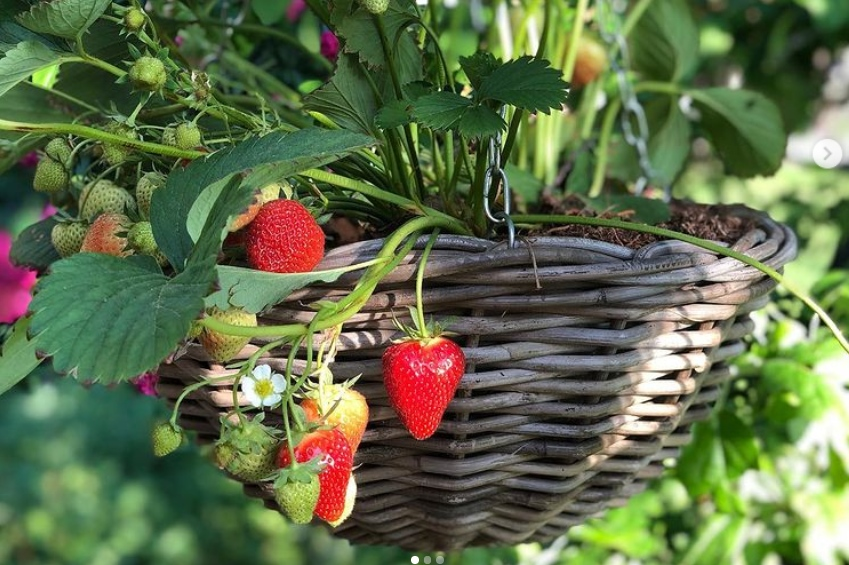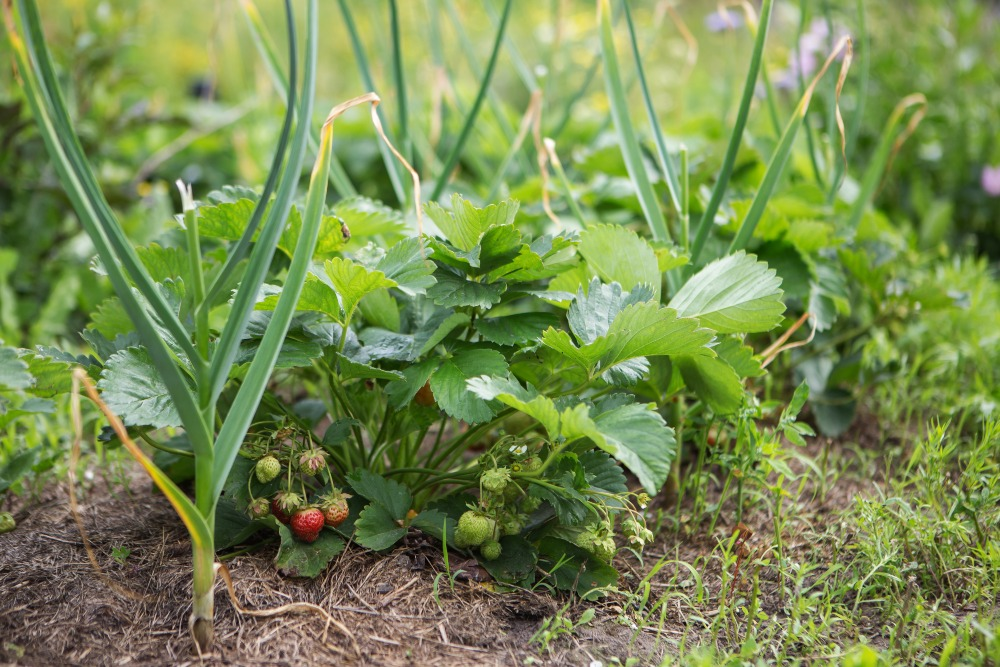Varied planted beds, tubs or balcony boxes not only look great, the colorful variety also offers a number of advantages if you pay attention to which plants you combine with each other. Because there are so many plants to choose from, we’re featuring plant teams that go particularly well together. We start with the juicy-sweet strawberry and the spicy-hot chives – here we go!
Opposites attract
Today we start with a classic of mixed culture, a famous, always working and just absolute dream couple: Strawberry and Chives! Whether our Bloomify plants Enno and Siggi or other varieties, this plant community works just wonderfully. The demands of the two harmonize super with each other and they do not steal each other’s butter from the bread .
Like all leek plants, chives have properties that have a positive effect on the strawberry – we’ll get to that in more detail below. Another advantage of this combination is that both plants are perennials. Once planted, they can thrive in the same place for several years and thus be firmly planted. In addition, both also grow very well in the tub.
Die Pflege kurz zusammengefasst:
| Strawberry | Chives |
| likes it as sunny and warm as possible is very thirsty (but please no waterlogging) is hardy needs a protected, but still airy location (do not plant too densely) has a moderate nutrient requirement (medium grower) | likes a sunny to semi-shady spot has moderate water requirements is hardy is a low grower, needs little extra nutrients very hardy to pests and diseases has edible flowers |

Strawberry & chives – the advantages of being neighbors.
Chives: disease defense included
In addition to well-matched care requirements, this duo has even more to offer; namely, chives are among the plants that have a positive effect on strawberries and benefit their health. Strawberries are a little picky about their neighbors (cabbage, in particular, should be kept as far away as possible) and, on the whole, are not as robust against diseases and pests as some other plants.
Along with onions, leeks and garlic, chives belong to the leek genus, all of which contain the substance allicin. On the one hand, this provides the typical oniony smell of the plants, and on the other hand, it has proven to be very effective in keeping fungal spores, bacteria and pests away from the strawberry. These are often attacked by gray mold, which is reliably decimated by the presence of chives & Co.

Growth habit & nutrient requirements
The growth habits of both plants are also complementary. Strawberries tend to grow low and bushy and need plenty of fresh air and open space. Overhanging plants would be a horror to it and it would wither in their shade. Not so next to chives: its slender, half-margined foliage grows upright and only reaches about 30 cm in height. Thus, it does not shade the strawberry and gives it the space it needs to stay healthy.
In terms of nutrient requirements, these two plants are also very well matched. Chives, as a low grower, require hardly any nutrients, so the strawberry can comfortably help itself to the soil to gather energy for its strenuous flowering and fruiting. Both together do not overly leach the soil – the strawberry is a medium eater – so you don’t have to constantly re-fertilize and the plants can stay in place for a long time.
Flower magic: insect dreams come true
Combining strawberries and chives in a bed is also a smart decision in terms of flowering and harvest time, as both are permanent crops that take up space in the bed. Our Bloomify strawberries bear their ripe fruit between July and September, so the flowering period begins in late spring, which we and the insect world can enjoy in advance. In the case of chives, harvest time begins much earlier – in May – and lasts until October. So you’re supplied with fresh chives all season long, and there’s certainly enough to freeze and stock up on for the winter. Chives also have wonderfully decorative and numerous flowers. They are arranged in a spherical shape and bloom in an intense purple. They are edible and not only a real treat for the palate and eyes, but also extremely popular with insects, especially bumblebees and butterflies, which are attracted as pollinators for the strawberry.
Who else fits?
Admittedly, chives and strawberries are already a really fragrant plant team. But maybe you have already planned your strawberries or chives differently in the bed and need alternative combination possibilities? Then we have a few great examples for you:
Chives repel fungi and diseases not only from strawberries. As a neighbor of the cucumber, it reliably keeps away powdery and downy mildew. The carrot fly also avoids chives, so they are almost predestined to keep the carrot company. Aphids and slugs prefer to give the aromatic plant a wide berth, and flowering plants benefit from chives because they magically attract insects. Thus, it is also super suitable as an underplanting for apple and cherry trees and tomatoes, makes a good figure next to roses and other herbs, such as rosemary, also appreciate its neighborhood.
Strawberries generally go very well with garlic and onion plants, all of which are good slug repellents. Tagetes and marigolds also make good bed neighbors and attract pollinators. Herbs, especially lemon balm, mint and dill, have an overall positive effect on strawberries and keep them healthy. However, since mint forms strong runners, you should rather plant it in a pot in the bed to keep it somewhat in check.
Strong together
It doesn’t matter whether you deliberately plant your garden in mixed culture or in some other way: It is always good to know which plants go particularly well together. This makes gardening much easier and you can enjoy a lush and healthy garden.
When it comes to planning your bed or container plants, and you want to grow in mixed culture, there are also a few things to consider in terms of crop rotation. If you are not yet familiar with the topic, you can read everything you need to know in detail in the article “Crop rotation and crop rotation – what’s behind it?”. Also super interesting: our overview and everything about the principles of mixed cropping.

